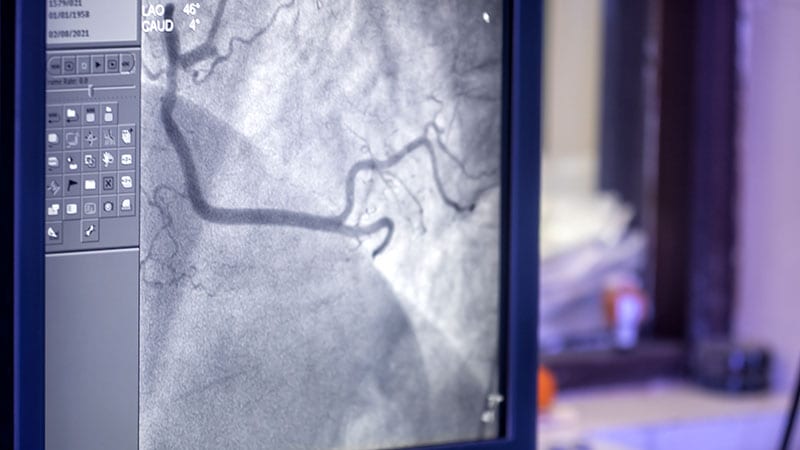Performing coronary reactivity (CR) testing during angiography in patients with angina without obstructive coronary disease (ANOCA) adds complexity and cost to the procedure but may, in the end, turn out to be a bargain.
A retrospective, single-center study suggests that CR testing in ANOCA patients can save money, perhaps a lot of money, probably by helping to limit downstream procedures and other use of health-care resources.
In the retrospective study, CR testing included both adenosine and acetylcholine challenges to differentiate endothelium-dependent from endothelium-independent coronary reactivity as the physiologic cause of ANOCA in individuals. Clarifying the cause at this stage of the patient’s clinical journey seemed to sharpen subsequent testing and management decisions, researchers say.
Of the 414 patients with ANOCA who underwent invasive diagnostic angiography, 207 also received CR testing during the procedure. The difference in total healthcare costs between the two groups over 2 years averaged about $20,000, largely due to the CR-testing group’s reduced use of downstream imaging, interventional procedures, and other tests, notes a report on the study published July 7 in Circulation: Cardiovascular Interventions.
For such patients referred for coronary angiography found to be without obstructive disease, “the right thing to do is a vascular reactivity test to assess if there is any abnormality that can contribute to this patient’s symptoms and events,” senior author Amir Lerman, MD, Mayo Clinic, Rochester, Minnesota, told theheart.org/Medscape Cardiology. Coronary reactivity testing “is expensive to set up initially, but it actually saves money by reducing the need for additional unnecessary testing and hospitalizations in these patients.”
The financial burden linked to the diagnosis and treatment of patients with chest pain is considerable, Lerman observed. It can involve a series of tests and culminate in a coronary angiogram. However, symptoms may continue if therapy does not correctly target one or more of several different potential mechanisms, including microvascular dysfunction and vasospastic disorders, he said.
“This paper says that if you establish a program of coronary reactivity testing you will ultimately reduce healthcare costs, because patients stop coming back to the hospital, or their physician stops ordering more tests or repeat angiograms because the patient has a true diagnosis,” observed Morton J. Kern, MD, University of California, Irvine, and VA Long Beach Health Care, California.
“That elimination of uncertainty and reduction of testing has a good payoff,” Kern told theheart.org/Medscape Cardiology. “The concept is good; the only challenge is that this is a complicated set of manipulations in the cath lab to get to the results.”
A minority of cardiac cath labs in the United States perform CR testing, despite its inclusion for ANOCA in guidelines from both the European Society of Cardiology and the American Heart Association/American College of Cardiology, the authors note. Cost and its requirement for specialized expertise may contribute to its poor uptake in practice.
In an editorial accompanying the report, Kern and David J. Cohen, MD, Cardiovascular Research Foundation, New York City, and St. Francis Hospital and Heart Center, Roslyn, New York, say they agree with the authors’ recommendation for more widespread use of CR testing.
However, they write, the initiation of a CR testing program is no small task. “In addition to motivated practitioners, operators with specific procedural expertise must have formalized technical training to produce valid results and to limit the procedural risks,” they write.
Moreover, expenses for a CR testing program “will likely be incurred without balanced reimbursement, but the healthcare system will benefit in the long run.”
The total health-related costs for the two groups of 207 in the analysis were tracked for 2 years after the procedure and found to be significantly higher (P < .001) in the group that had received coronary angiography without CR testing. Their average annual cost was $37,804 (range, $26,933 to $48,674), compared to $13,679 (range, $9447 to $17,910) for those that had undergone CR testing.
The angiography-only group’s costs for procedures (including surgical or percutaneous intervention, endoscopy, and bronchoscopy) averaged $5872 (range, $3798 to $7946) compared to $2104 (range, $1202 to $3006) in the CR testing group (P = .001).
Similarly, costs for any type of imaging, including at cardiac catheterization, averaged $2639 (range, $2093 to $3185) and $1426 (range, $1090 to $1761), respectively (P < .001).
Annual total hospital services costs were also higher in the angiography-only group, $21,820 compared to $6409 (P < .001) for the group that underwent CR testing.
Caution is required when interpreting these results, Matthew Tomey, MD, Mount Sinai Morningside Hospital and Icahn School of Medicine at Mount Sinai, New York City, told theheart.org/Medscape Cardiology by email.
“The observed cost differences are interesting and hypothesis-generating but they fall short of providing strong evidence that [CR testing] saves money or that [it] should be incorporated into routine practice,” Tomey said. “Multiple biases can skew findings of retrospective observational studies. A prospective, randomized study would be needed to draw stronger conclusions.”
Still, it’s true that “there is substantial opportunity to do better in diagnosing chest pain in our patients with no apparent, explanatory obstructive coronary atherosclerosis,” he said. “There are emerging invasive and non-invasive ways to do so. Helping our patients get to the right diagnosis is the right thing to do. It will lead to better treatment recommendations, improved patient symptoms, improved patient confidence, and — it stands to reason — cost benefits in the long term.”
The study was funded by a grant from Philips. Lerman reports receiving honoraria from Philips Volcano. Kern discloses speaking for Abbott Vascular, Boston Scientific, Acist, Opsens, and Zoll. Cohen discloses receiving institutional grant support from Abbott Vascular, Boston Scientific, CathWorks, and Philips; and consulting income from Abbott, Boston Scientific, and Medtronic. Tomey reports no relevant financial relationships.
Circ Cardiovasc Interv. Published online July 7, 2023. Full text, Editorial
Source: Read Full Article
